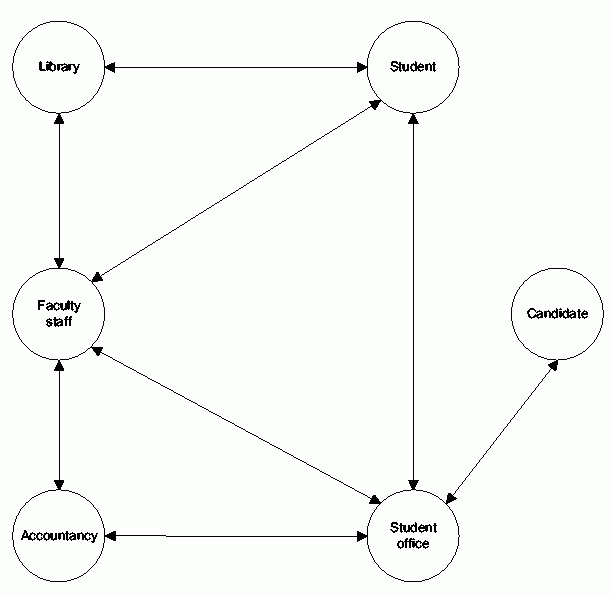University is an amphibian. It conducts pedagogic and educational activities on one hand, research and project activities on the other. Therefore an integrated university information system supporting all possible activities in the university is a rather complex system. The paper will discuss the structure of integrated university information systems. It will try to define the role of new technologies in the education process at university.
The need for information support is present at all levels at the University: student office and students at application level, university management at a tactical and a strategic level. It is quite similar to other organisations. The goal is to automate everyday simple processes and tasks and to enable strategic decisions to be made by the management [Mederly 97].
An information system consists of one or more application systems. But very often we use only the word information system, even for single programs and more often for the application systems. The word information system is therefore often misused.
A university information system that would support all activities in the university would consist of the following application systems [Vrana 97, Mahnic 97]:
There are several participants with different roles at the university. The interaction between them is shown in the picture on the following page:
Circles represent participants and lines represent interactions between them. Interactions are data flows passing from one participant to another. On his way between participants they are transformed by processes taking place in the university. Subsets of this diagram of interactions are sub-diagrams of the same type.
The above mentioned application systems could be represented by the following sub-diagrams:

In some of the application systems the use of new technologies (WWW, Internet, Intranet, …) would hardly add any new value and quality. The personnel and finance information system is a good example.
We cannot say the same for other application systems. The student record application system is the best example of one that would benefit. New technologies in that area could not only add new values to the existing processes, but also enable new activities and processes and (or) give them new quality.
From now on we will focus only on the role of new technologies to support the administrative component of the education process, and other processes otherwise supported by student record application system. We will also try to find out new processes that could not before be executed.
The typical student record application system runs on DOS and is developed in Clipper. It supports administrative activities and some analysis. Technology limitations of DOS and Clipper prevent it using new technologies. Our ideas and conclusions are based on the student record application system of university of Ljubljana. It can be statistically considered as a typical European student record application system [Mederly 97].
Today's typical student record information system supports mainly interactions between the student's office and students on one side and on the other interactions between student's office and faculty staff. There is a lack of supporting interactions between students and faculty staff. What would an ideal student record application system be like? Our vision of an ideal student record application system follows.
Let's first define what is an ideal application system. Here are some of its characteristics:
The main problem with typical student record application system is that students and faculty staff are unhappy to use it. Students would want to use a WEB based application system. They would like to apply to exam using the Internet at home, they would like to see results of exams using Internet instead of looking at the boards. Happiness and satisfaction at work are very important factors and are the basic condition for effective work.
New technologies could add new value or give new quality to interactions starting or ending at the student office. The ideal student record application system would also support interactions between faculty staff and students [Kammerer 97]. Some examples:
New technologies on one hand give new value to the interactions between participants and processes accompanying them. We can talk about new value if an interaction or process is by use of new technologies either: quicker, simpler or more effective. Some of the interactions and accompanying processes are given new quality by the use of new technologies and would otherwise not be possible.
In order to understand the qualitative difference between new value and new quality there is the following example. Applying for exams using an Internet browser gives this process new value, because it can be executed quicker and from practically anywhere. But forming discussion groups is something which could not be realised without the use of new technologies. That is the new quality.
The following question arises: "What do modules, supporting processes, giving new quality, represent?" New type of application system? Just a new branch of modules of student record application system?
We think that it is a new type of application system. It cannot be just a branch of modules in a student record application system. The student record application system is of an administrative nature whereas this new type of application system supports interaction between faculty staff and students. It therefore supports the educational process and is becoming very important, because it directly influences the satisfaction of students and the quality of education process.
[Mederly 97] Mederly, Peter: Annual EUNIS Report on University Information Systems in Europe, Proceedings of EUNIS 97 Conference, 1997
[Vrana 97] Vrana, Ivan: An Integrated Implementation of University Information Systems, Proceedings of EUNIS 97 Conference, 1997
[Mahnic 97] Mahnic, Viljan: Towards the re-integration of the University of Ljubljana information system, Proceedings of EUNIS 97 Conference, 1997
[Kammerer 97] Kammerer, Ulrich: i3vreg. - education An approach for an integrated university information system, Proceedings of EUNIS 97 Conference, 1997
Rok Rupnik, Marko Bajec, Marjan Krisper
University of Ljubljana, Faculty of Computer and Information Science
Trzaska 25, 1000 LJUBLJANA, SLOVENIA
e-mail: rok.rupnik@fri.uni-lj.si, marko.bajec@fri.uni-lj.si, marjan.krisper@fri.uni-lj.si